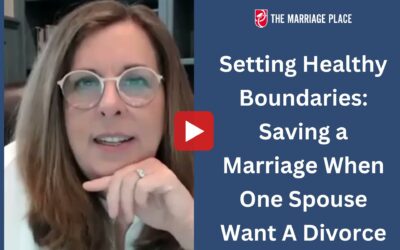The art and science of non-sexual touch
March 19, 2018

“I obviously work with a lot of couples who are dissatisfied sexually. As such, I find myself writing frequently about sex. Like here. Also here and here.
One thing I haven’t written about before – and probably should have – is the importance of non-sexual touch in a relationship.
While there are no quick fixes and no single road map that fits every couple (that’s why all the work we do at The Marriage Place is customized to the couple), you might be surprised at how often I ask couples that are struggling in the bedroom to first focus on activities outside of the bedroom.
Non-Sexual Touching
One of the things I teach my clients is to be deliberate about increasing non-sexual touch.
What tends to happen within a couple – especially a couple where the partners have distinctly different sex drives (which is most couples, by the way) – is that the lower desire spouse will quit touching the higher desire spouse because any touch is interpreted as an invitation for sex. Many of you know exactly what I’m talking about. Your husband walks by you in the kitchen, gently pats your backside, and your brain goes straight to “He’s expecting sex tonight”. Or husbands, your wife puts her hand on your arm as she’s asking a question and it translates to “I’m going to get lucky!” Invariably, one or both partners in these situations end up frustrated or resentful.
Why Non-Sexual Touch is Important
Touching without the expectation of sex can be a deep bonding experience. It builds a level of trust otherwise missing from the relationship, which in turn, enhances the couple’s sexual relationship as well.
When couples quit touching, hugging, and kissing except as a prelude to sex, the passion in the relationship usually dies. In fact, I can often gauge a couple’s sex life before they tell me anything about it, simply by how much they touch each other in a non-sexual way.
What Non-Sexual Touch Looks Like
Non-sexual touching can be holding hands or cuddling during a movie or just sitting close enough to each other that you are touching arms or legs.
Really, it can be any touch that you both agree is not intended to lead to sex. The list of options is limitless, but here are a couple of purposeful ones if you are looking to be intentional.
The 3-Minute Hug
It’s as simple as it sounds. Hug your partner (we’re talking full body hug) for 3 straight minutes. You can even set a timer. I’ll warn you though – 3 minutes can feel like forever, especially if this is the first time. So if needed, start with just one minute and work up to it.
Occasionally I’ll have my clients hug during a session. If I were to video you’d notice a few things. First, couples often start out in a stiff awkward embrace. Their eyes jump around looking for distraction and at least one will glance at me with that “How much time is left?” look. But as the seconds tick off, I start to see some changes. Both partners will shift to get comfortable. Their bodies relax, often kind of melting together. Their breathing slows and begins to regulate, even to the point where they may breathe in unison. All in a matter of 3 minutes.
The 30-Second Kiss
Most couples typically kiss for just a split second at a time. It’s the quick peck as you are leaving for work or the greeting when you get home in the evening.
What if you kissed your partner for a solid 30 seconds each day?
30 seconds isn’t that long, but an intentional half a minute of kissing will feel like much longer (You can thank me later). It’s long enough that you can’t fake it and you are forced to connect with each other. In fact, it’s nearly impossible to kiss that long and not feel closer to your partner.
The Science Behind it
Physical contact like hugging and kissing causes your body to release endorphins and oxytocin. Endorphins are the natural “feel-good” chemicals we all have that reduce stress, anxiety and depression. Oxytocin is known as the “bonding hormone.” Our skin has receptors that stimulate our brain to produce more of these chemicals. So more hugging & kissing = more endorphins & oxytocin = more happiness, less anxiety, and more physical intimacy.
Now this, by itself, does not guarantee more or better sex. I can tell you this though – show me a couple with limited (or no) non-sexual physical intimacy, and I’ll show you a couple that is also struggling in the bedroom. The two are connected.
In case you haven’t noticed, none of this work can begin without open, honest, direct dialogue with your partner. If you aren’t having those now on other topics, starting with sex may be awkward. Really awkward. But that’s okay. Do it anyway!
Interested in possibly working with us?
You may also like:
Be Curious, Not Furious – A Tip To Improve Communication In Your Marriage
A lot of the therapy work I do is helping couples and partners understand what their contributions to the relationship are, and how they can start making changes for the better, specifically with communication. Specifically, when communicating with your spouse, it’s important to make sure that you are not part of the problem, but part of the solution.
On Brene’ Brown’s “Marriage is never 50/50” Discussion
I bet many of you have already seen the recent Brene’ Brown video making the rounds where she calls out the myth of marriage being a 50/50 partnership.
Setting Healthy Boundaries: Saving a Marriage When One Spouse Want A Divorce
I get asked a lot how to save a marriage when one spouse is leaning out or is contemplating divorce. Everybody’s situation’s different, but what I’m seeing a lot lately is very concerning to me.




0 Comments